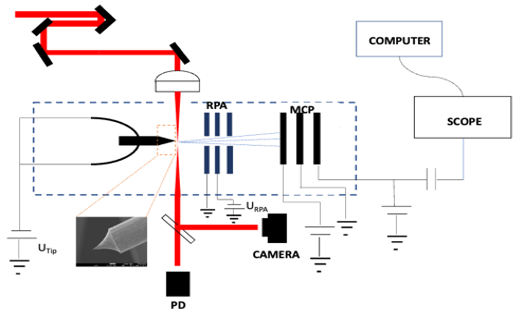Speaker
Description
Electron emission from nanometer-scale metallic tips has gained significant interest due to field enhancement at the apex, enabling emission at lower intensities [1]. Laser-induced field emission from sharp tips has paved the way for ultrafast pulsed electron sources with high spatiotemporal resolution. While previous studies focused on light polarization and incidence angle effects [2], we investigate the influence of laser pulse repetition rate on electron emission from a tungsten nanotip.
A tungsten nanotip (100 nm radius) was fabricated via electrochemical etching and characterized using SEM and an automated computer vision-based method [3]. A femtosecond laser (170 fs, 1.034 µm) with tunable repetition rate (1–100 kHz) was loosely focused onto the nanotip inside a 10⁻⁷ mbar vacuum chamber. The laser polarization was aligned parallel to the tip shaft, and a 600V DC bias was applied. Electron emission was detected using an MCP-phosphor screen assembly.Imaging a micron-scale copper mesh confirmed the nanometric origin of the emission.Our findings provide crucial insights into optimizing ultrafast electron sources, advancing applications in ultrafast imaging and coherent electron beam generation. The schematic of the experimental setup is given in Fig[(a)].
The repetition rate of laser was varied from 1KHz to 100KHz by keeping the pulse energy constant, 40 μJ and 60 μJ.Repetition rate dependance of electron emission from nanotip is given in Fig[(b)].

The electron emission from the tip was found to decrease with increased repetition rate of the laser. This observation may be attributed to the microscopic local electron distribution on the tip.Considering the following model:
\begin{equation}
\frac{\partial n}{\partial t} = b(n_e - n) \tag{1}
\end{equation}
This equation is similar to the diffusion equation, where the rate of change of electron density is proportional to the difference between the density at time $t , n(t)$ and the equilibrium density $ n_e $
Integrating the above equation, we obtain:
\begin{equation}
n(t) = n_e \left( 1 - k e^{-bt} \right) \tag{2}
\end{equation}
where the parameter $ \frac{1}{b} $ is the relaxation time.
Using the boundary condition at ( t = 0 ) just after electron tunneling:
\begin{equation}
k = \left( 1 - \frac{n(0)}{n_e} \right) \tag{3}
\end{equation}
which implies:
\begin{equation}
n_e k = (n_e - n(0)) \tag{4}
\end{equation}
When the pulse energy is higher, the initial density $ n(0) $ should be smaller. Consequently, $ n_e k $ should be higher. This result is in agreement with our experimental findings.
To conclude, the laser repetition rate can be used as a parameter to control the electron emission from nanotip which can be used as an efficient source for time-resolved electron interferometry and for time-resolved nanometric imaging.
References
[1]Hommelhoff, Peter and Kealhofer, Catherine and Kasevich, Mark A., "Ultrafast Electron Pulses from a Tungsten Tip Triggered by Low-Power Femtosecond Laser Pulses","PhysRevLett.97.247402(2006) "
[2] Yanagisawa, Hirofumi and Hafner, Christian and Don\'a, Patrick and Klockner, Martin and Leuenberger, Dominik and Greber, Thomas and Osterwalder, Jurg and Hengsberger, Matthias, "Laser-induced field emission from a tungsten tip: Optical control of emission sites and the emission process," PhysRevB.81.115429(2010).
[3] Wei-Tse Chang, Ing-Shouh Hwang, Mu-Tung Chang, Chung-Yueh Lin, Wei-Hao Hsu, Jin-Long Hou; "Method of electrochemical etching of tungsten tips with controllable profiles ", Rev. Sci. Instrum. 83 (8): 083704(2012)


